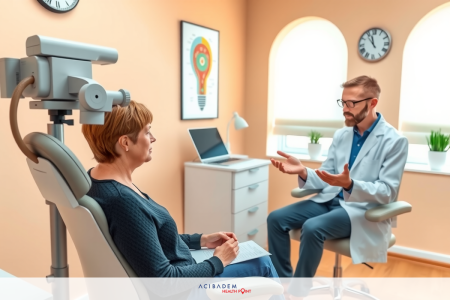Neurotrophic Keratitis: Causes & Care
Neurotrophic Keratitis: Causes & Care Neurotrophic keratitis is a rare and serious ocular surface disease. It’s a condition that needs careful attention. It can harm your eye health.
We’ll talk about what causes it, what symptoms to watch for, and how to care for it. Knowing about this condition helps you take good care of your eyes. Let’s explore how to deal with neurotrophic keratitis from start to finish.
Understanding Neurotrophic Keratitis
Neurotrophic keratitis is a rare eye disease. It happens when the nerves to the cornea don’t work right. This leads to damage and trouble healing the cornea.
Definition and Overview
This disease shows up with signs like ongoing eye sores and ulcers. Sometimes, it can even melt the cornea. It comes from things like viruses, surgery, or other diseases that hurt the nerves around the eye.
Without feeling in the cornea, the eye can’t protect itself. This means no blinking or tears to keep the eye moist and healthy.
Historical Context and Discovery
People first noticed this disease a long time ago. They saw it in patients with nerve damage in their face or head. Over the years, we’ve learned more about it thanks to new technology and research.
Researchers have figured out how nerve damage starts and makes this disease worse. Now, we can spot it early and help patients better.
| Aspect | Details |
|---|---|
| Historical Reference | Initial description attributed to early studies on nerve damage eye conditions |
| Significant Milestones | Enhanced diagnostic techniques, improved understanding of corneal disease mechanisms |
| Current Understanding | Comprehensive knowledge on the link between corneal sensation loss and neurotrophic keratitis |
Causes of Neurotrophic Keratitis
Neurotrophic keratitis is a condition that harms the cornea. It comes from many things. These include nerve damage, losing feeling in the cornea, and some health issues.
Corneal Nerve Damage
Damage to the corneal nerves is a big cause of this condition. It stops the nerves from sending important messages. This can happen from surgeries, infections, or injuries.
Corneal Sensation Loss
Not feeling things on the cornea is bad for your eyes. Without feeling irritation or injury, the cornea can’t heal right. This makes it more likely to get infections and make the condition worse.
Underlying Medical Conditions
Some health issues can lead to neurotrophic keratitis. Diabetes, multiple sclerosis, and some tumors can hurt nerve function. This makes it harder for the cornea to feel things and heal right. Knowing these risks helps in fighting the disease.
Symptoms of Neurotrophic Keratitis
Symptoms of neurotrophic keratitis can be mild at first or very clear later on. It’s important to know these signs to start treatment early.
Early Signs
At the start, you might feel a weird feeling in your eye or see it turn a bit red. This can seem like normal irritation. You might also see things blurry because of small problems with the cornea.
Spotting these signs early is key to stopping the disease from getting worse.
Advanced Manifestations
As the disease gets worse, the symptoms get more serious. These signs tell you it’s time for serious treatment:
- Significant pain reduction, not because of healing, but due to nerve damage causing loss of corneal sensation
- Persistent eye redness and noticeable swelling
- Severe visual impairment due to extensive corneal epithelial breakdown
- Formation of corneal ulcers, increasing the risk of infections
If you see these bad signs, you need to see a doctor fast. This can help stop serious damage and problems. Knowing the signs of corneal disease helps doctors treat you right.
| Stage | Symptoms | Implications |
|---|---|---|
| Early | Discomfort, mild redness, initial vision blurring | Need for initial examination |
| Advanced | Reduced pain, severe redness, vision loss, ulcers | Urgent neurotrophic keratitis treatment required |
Knowing both early and late signs is key to keeping your eyes healthy. Watching closely and getting the right treatment can stop serious problems and make life better.
Diagnosis of Neurotrophic Keratitis
Diagnosing neurotrophic keratitis needs a full check-up. It uses both clinical checks and tests. This way, doctors can look at all parts of the eye carefully. It helps them make a clear and quick diagnosis.
Clinical Evaluation
Ophthalmologists look at the patient’s health history first. They also do a detailed eye check-up. This includes:
- Checking how well the patient can see and looking for vision problems.
- Using a slit-lamp to closely look at the cornea and eye surface.
- Testing how sensitive the cornea is with special tools to see if it’s numb.
Diagnostic Tests
To be sure about the diagnosis, doctors use special tests. These tests help find out if the eye has neurotrophic keratitis. Some tests used are:
- Fluorescein Staining: This test puts a dye on the eye to show damage or odd spots.
- Schirmer Test: This test checks how many tears the eye makes. Tears help keep the eye healthy.
- Corneal Confocal Microscopy: This gives a clear picture of the corneal nerves. It helps see nerve damage.
By looking at both the clinical check-ups and tests, doctors can make a good diagnosis. It’s important for patients to know why these steps are needed. This helps keep their eyes healthy and gets them the right treatment fast.
Pathophysiology of Neurotrophic Keratitis
Neurotrophic keratitis is a complex issue. It happens when the nervous system and the cornea don’t work together well. This leads to big problems in treating the condition. We’ll look at how nervous system issues cause neurotrophic keratitis and slow down healing.
The Role of the Nervous System Disorder
Having a nervous system disorder is a big part of neurotrophic keratitis. Things like herpes zoster, trigeminal neuralgia, or surgery mistakes can hurt the trigeminal nerve. This nerve helps the cornea feel things and react to harm.
When the nerve gets damaged, the cornea can’t feel injuries or infections. This makes it harder to stop problems before they get worse.
Corneal Healing Impairment
Patients with neurotrophic keratitis have trouble healing. Normally, nerves send out chemicals that help fix and grow new cells. But with a nervous system disorder, these chemicals don’t work right. This means healing is slow or not complete.
Also, not feeling things in the cornea means you can’t blink to protect it. This makes it more likely to get ulcers or other serious problems.
| Factors | Impact on Corneal Healing |
|---|---|
| Neuropeptide Release | Diminished, resulting in poor epithelial regeneration |
| Corneal Sensitivity | Reduced, increasing vulnerability to injury |
| Reflex Actions | Impaired blinking reflexes lead to inadequate corneal protection |
Learning about neurotrophic keratitis shows why we need to act fast and find new treatments. By fixing the nervous system issue and helping the cornea heal, doctors can better help people with this condition.
Progression of the Disease
Neurotrophic keratitis goes through three main stages, each getting worse. Catching it early is key to slowing it down and keeping your vision safe.
Stage 1:
This first stage has mild symptoms like small spots on the cornea and small scratches. You might not feel much pain because the cornea doesn’t feel much. It’s hard to know you’re getting worse.
Stage 2:
Things get worse, and the cornea gets more damaged. You might see things less clearly, but you might not hurt much yet.
Stage 3:
In the last stage, the cornea can get very badly damaged or even break open. If not treated quickly, you could lose your sight forever.
| Neurotrophic Keratitis Stages | Symptoms | Potential Complications |
|---|---|---|
| Stage 1 | Slight punctate keratitis, epithelial erosions | Initial corneal disease progression, mild visual changes |
| Stage 2 | Persistent epithelial defects | Visual disturbances, increased risk of infection |
| Stage 3 | Severe ulceration, potential perforation | Permanent vision loss, significant ocular health deterioration |
Knowing how the disease gets worse helps us manage it better. Catching it early and treating it right is key to keeping your eyes healthy. This shows why taking good care of your eyes is so important.
Treatment Options for Neurotrophic Keratitis
There are many ways to treat neurotrophic keratitis. These range from simple treatments to surgery. New research is making things better for people with this condition.
Medications and Therapies
Medicines are a key part of treating neurotrophic keratitis. Eye drops and ointments keep the eyes moist and safe. Some eye drops use the patient’s own blood to help heal and ease pain.
Therapy for the eye’s surface might include special contact lenses. These lenses protect the cornea and help it heal. There are also treatments that help bring back feeling in the cornea.
Surgical Interventions
If medicines don’t work, surgery can help. A surgery called tarsorrhaphy closes the eyelids to protect the cornea. Another surgery uses a special membrane to help the eye heal.
| Treatment Method | Description | Benefits |
|---|---|---|
| Autologous Serum Drops | Eye drops made from patient’s blood serum | Promotes healing and reduces discomfort |
| Therapeutic Contact Lenses | Special contact lenses to protect the cornea | Shields the ocular surface, promotes healing |
| Tarsorrhaphy | Partially or fully closing the eyelids | Protects the cornea from further damage |
| Amniotic Membrane Transplantation | Transplanting amniotic membrane onto the ocular surface | Offers a biological bandage rich in growth factors |
Advancements in Eye Care Research
New research is bringing hope for better treatments. Gene therapy could fix the root cause of the problem. New materials are also leading to better eye care.
Using artificial intelligence helps doctors find the best treatments for each patient. This means better care for those with neurotrophic keratitis. It looks like the future is bright for this condition.
Living with Neurotrophic Keratitis
Living with neurotrophic keratitis is tough, but you can make it easier. Knowing how to handle symptoms and finding support helps a lot. It’s important to manage symptoms well and use the right resources.
Managing Symptoms
Managing this condition means using both medical help and taking care of yourself. You should take your medicines as told, like eye drops, antibiotics, or steroids. These help control symptoms and stop more problems.
Also, doing some things every day can help:
- Regularly applying lubricating eye drops
- Protecting eyes from irritants and too much screen time
- Keeping yourself hydrated
Watching for any changes in your symptoms and getting medical help quickly is key.
Impact on Eye Health and Vision
Neurotrophic keratitis is a serious condition that can harm your eyes. It’s important to watch out and take steps to protect your eyes. This can help keep your vision clear and avoid bad outcomes.
Potential Complications
Not treating neurotrophic keratitis can lead to big problems. Potential complications include:
- Ulceration: Your cornea might get ulcers, causing infections and worse vision.
- Scarring: If the cornea gets damaged, it can scar, leading to losing your sight.
- Perforation: In the worst cases, your cornea can perforate, needing quick medical help.
Preventive Measures
It’s key to prevent these problems with neurotrophic keratitis. Here’s how:
- Regular Eye Examinations: Seeing eye doctors often helps catch issues early.
- Protective Eyewear: Wearing safety glasses can protect your eyes from injury.
- Medication Adherence: Taking your medicine as told can stop the disease from getting worse.
| Preventive Measure | Benefit |
|---|---|
| Regular Eye Examinations | Finds problems early for quick treatment |
| Protective Eyewear | Lowers the chance of eye injuries |
| Medication Adherence | Keeps the disease under control |
Knowing how neurotrophic keratitis affects your eyes and preventing it can help keep your vision good. This way, you can avoid the bad effects of this condition.
The Role of the Acibadem Healthcare Group
The Acibadem Healthcare Group is a key player in eye health services. They lead in treating neurotrophic keratitis. Their facilities use the latest in medical tech for complex eye problems.
They mix advanced tech with caring for patients. This makes them leaders in solving neurotrophic keratitis issues.
At the heart of Acibadem’s work is a team of experts. They include ophthalmologists, neurologists, and corneal specialists. Together, they create custom treatment plans for patients.
Their research has greatly helped understand neurotrophic keratitis. This has led to new treatments and better patient results. Acibadem is dedicated to top-notch eye care, from start to finish.
Worldwide, Acibadem is known for its medical know-how. They do more than just treat patients. They also lead in research that shapes how we treat neurotrophic keratitis.Neurotrophic Keratitis: Causes & Care
By investing in research and new tech, Acibadem shines as a hope for those needing eye care. They are a guiding light for patients everywhere.
FAQ
What is Neurotrophic Keratitis?
Neurotrophic Keratitis is a rare eye disease. It happens when the nerves in the cornea get damaged. This makes the cornea less sensitive.
What causes Neurotrophic Keratitis?
It's caused by damage to the corneal nerves. This can happen due to diabetes, herpes zoster, or surgery.
What are the symptoms of Neurotrophic Keratitis?
Symptoms start with dry eyes and mild eye problems. They can get worse to corneal ulcers and blurry vision.













